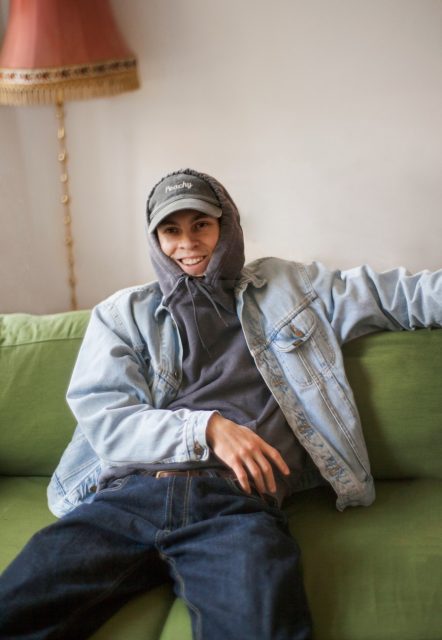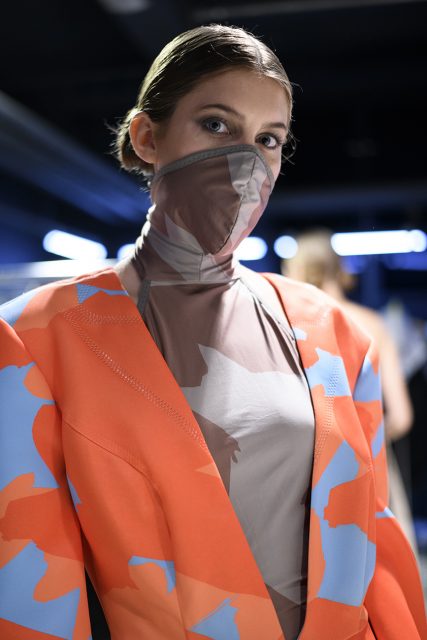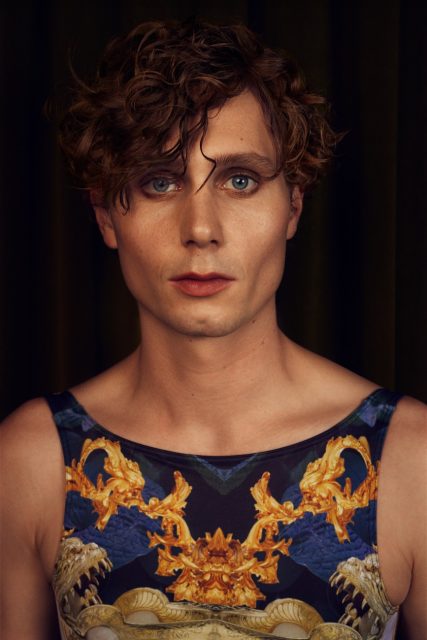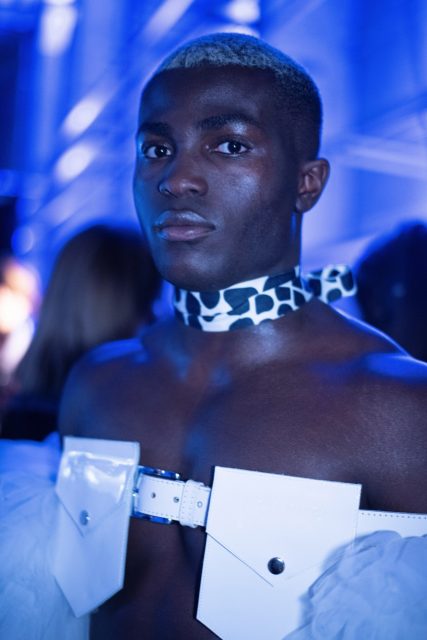Over the last twelve years, Julian Zigerli has worked endlessly to maintain a relevant place in the fashion world. Whether lecturing and coaching the next generation of designers at Universität der Künste in Berlin or turning out collections for his namesake brand, he always has his fingers in many pies.
Looking back to where it all began, Julian told us: “The first shops were in Tokyo, Hong Kong, Milan, and New York. There was nothing in Switzerland, not even Europe. It was very “abroad” and at some point, Switzerland came closer and closer. We only started doing shows in Zurich in 2018.” Akin to his brand, he has made a holistic journey back to his homeland. Julian now spends a large share of his time dedicated to his flagship store in Zurich. His most recent project for JULIAN ZIGERLI follows the tradition of playfully-named collections. “Rock, Paper, Scissorli” consists of five “drops”, which took place throughout the year. This is the second time he experiments with this style of release.
Always keen to blur boundaries and break traditions, Julian teamed up with Swiss artist Katja Schenker for the Rock, Paper, Scissorli show. Katja’s artistic works focus on the areas of live performance, drawing, sculpture and installations, highlighting the use of natural materials in most cases. The sensuality of these materials plays an important role, as do their context, as well as their spatial and temporal dimensions, such as mass, permeability or perishability. Not only did Katja curate a live performance for the show but she and Julian worked together to create the stone and wood print garments for the collection.
We caught up with Julian and Katja after the show to find out more about the possibilities of collaborative work and finding models on Grindr.
Œ: Originally, ZIGERLI started as a menswear brand. Over the years, it has gone through multiple evolutions. You now have kidswear too – How did that come about?
Julian: Starting as a menswear-only brand, we realised from day one that it wasn’t just menswear, it’s for the people. From the beginning, we had a lot of female customers because they appreciated the sporty shapes of the garments and the easy ways to wear the garments. So this was a natural evolution. We also don’t necessarily call it unisex. I feel like that’s not the case. Instead, just come to the shop and pick a piece you like, try it on and if it fits, it fits!
As for the kids, ever since my family got a bit bigger and my brother had two kids, I needed some gifts for them *laughs* So we started with little accessories like caps and we’ve been building this up, we even did a family sweater. The sweater with the cows was originally for grown-ups, and it was such a success. Then I thought: “This is the cutest thing for kids!” So we added it. It’s only about four pieces for kids so you couldn’t call it a “kids line”. But it shows how flexible we are. We can just adapt to any situation.
I remember back in the days everyone kept asking me. So for whom do you design for? It was always hard to answer because when I’m in the shop, I sell to everyone. It doesn’t really matter what age or gender you are. I think we proved that with the show. Age and gender just evaporate!
Œ: It was so heart-warming to see that you had colleagues, friends, family and even people you met through “interesting encounters” wearing the collection – Why did you choose to do this instead of using a traditional modelling agency?
Julian: I always love to cast my own models. I’ve had so many campaign shoots with people, who I met at the store. I was like, “Hey! You’re not leaving before I take a picture of you!” I ask people I meet to come do campaign work for me. 3 months ago, when I started to think about how we were gonna present the collection, I saw a friend of mine in a coffee place and he is this older, really tall and beautiful guy with grey hair. That’s when I thought, “Oh, maybe we should make this a focus?” Like less agency-focused people.
So I collected all the faces throughout the months. In the studio, we made this wall with people who could potentially model for us and in the process, a lot of friends ended up there. I even went to Grindr and scouted two guys. I asked myself, “Where do you find sexy daddies?” *laughs* I think that this place isn’t it. I mean, it’s not that easy – it’s a bit awkward. When I reached out to my brother because I needed his kids for the show, I suggested that he also walks in it – he’s a tall and handsome guy. So yeah, it just kind of came together like this. When I look at the group picture, it makes me so happy to see all these faces.
 |
 |
 |
Œ: Katja, for the show you curated a live performance. Could you describe for those who weren’t present what that performance consisted of?
Katja: You say “curated” but I was also the performer! That’s what I always do because some things can only be decided on the spot, I can’t prepare everything. That was also the case with the piece – Julian and his team, and I prepared this concrete dress. We looked at how it has to be from the fabric coming from my studio and I worked on this net structure. It’s just a fishing net you can find at any sports fishing shop. The dress was already finished so we had to cut it in a way that it could be flat when I poured the concrete in a layer of half a centimetre onto it.
At first, it was like armour with hard concrete edges, and then once I got onto the catwalk, the surface started to crack, and I made these cracks audible for the public to make clear the performance was starting. The dress changed immediately from something very rigid to something soft and smooth, a textile piece. With every movement, the dress changed. In the end, we had this dress with lots of holes and a snake-like structure.
Œ: You mention this snake-like structure of the dress. Your artworks typically aim to heighten the experience and perception of one’s corporeality concerning the bodies of the audience and that of the artist. How did you become interested in the body and skin in your artistic practice?
Katja: I have always said this is a very long relationship and interest. because in the end, the body is this thing you have and will always have. I want to use it, take it and feel connected with it. Through the body, we connect with other people but also with material and non-material. So for me, the body has always been the starting point of all of my artworks. I see the body as a space, and now I am working more with this idea of space – the body as and within a space. I am sensitive to the body and its relation to materials and how they feel. Our skin is the closest material we can feel and connect with.
 |
 |
 |
Œ: How did this working relationship or idea to work together come about?
Julian: I think I first saw her monolith in the FHNW Campus in Muttenz, it’s a university for architecture and social work – it’s quite a new house. I was working there with my students and Katia made this huge monolith piece in the middle of the hall. I saw this piece and I was, like, blown away. I just wanted to touch it, to hug it, I think I even wanted to become it *laughs* That’s when I started to follow her work and we started to connect on Instagram.
We never met, but we chatted a bit and at some point, the Kunsthaus in Zurich made a new shop and asked me if we could create a product for the new shop. I was like, “Yeah, of course, but if I do this, it needs to be with an artist.” I wanted to have the context of this museum and the first person who came to mind was Katja. I thought, “Maybe now is the time we can start to work together. Let’s do this!” So we made this silk scarf *points to Katja* She’s wearing one right now, and this was the beginning. The flow was so easy. We understood each other very well and the product was really beautiful. So I was like, “OK, this is to start like this is not enough. We need more.” Immediately the scarf went into the collection plan and that’s where it started.
Œ: Whilst fashion and art have a very natural overlap, there are also differences in your artistic practices – Did you encounter any in the process?
Julian: I think one of the biggest differences is that we create something more commercial for the client to buy right away from the shop. We also create something for the body and not for the wall or the room, or like it’s for a human body. It was interesting for us to create this mesh dress for a performance, thinking we were not intending to sell this. But it somehow all came together. She needed us to create this dress, and we needed her for it to become what it was. It had to be this catwalk situation because it was this middle line of fashion, art and performance.
At first, we planned to have the show and also an exhibition space at the same time. And it was all just too much so we decided to narrow it down. Let’s put everything on the runway. Let’s make it fashion and art in one. And I think this worked well. When the models came out wearing the garments, we also had the artwork walking with the models. You know, there were some art pieces on the catwalk as well.
Katja: I would say I’m really happy with this result with mixing up the artwork and the clothes, which are kind of artworks in themselves. For me, it’s always important to destroy these barriers and to open up my work to different fields like architecture or here. Fashion was the first time for me, but very inspiring and as Julian described with the collaboration of the performance dress, it was really, um it was a mix of art and fashion.
 |
 |
 |
Œ: Julian, you’ve worked at the Fashion Design Institute of the HGK/FHNW in Basel and you even work as a Fashion Design Professor at the UdK in Berlin – What is it about teaching fashion that you enjoy the most? Has it created any realizations within yourself?
Julian: It’s like a mirror. Everywhere I teach, I learn a lot from them as well, from their creative processes and mindsets. I’m still teaching at the UdK for another year because I have this guest professorship there. I try to do projects with them and bring in more industry-focused teachings. With my brand, we are less traditional, we don’t create on a seasonal basis with just two collections so I started to change the whole concept of this with my teaching. I also try to teach them to think at their own pace and in their own way- like how they want to present their collection. Like all the parts that made my brand unique, I try to hand these ideas over to them, and hopefully, this inspires their ideas too.
Œ: What is your best advice for young and independent designers?
Julian: I have one phrase: Marry rich! *laughs* You need a lot of money if you don’t. If you don’t and you also don’t have lots of money, like most of us, you just need to fight! You have to be strong about it. You have to be focused on yourself and the work you do. And trust yourself as well. Most importantly, you need to be patient.
 |
 |
 |
Œ: Katja, are you currently working on any upcoming exhibitions we can pop into our diaries?
Katja: I had a residency in London for half a year in Whitechapel, which I loved. During it, I started a new drawing series related to the body. It started with body prints combined with linear drawings. This series is now exhibited in the Galerie Mitterrand in Paris until the 6th of May so I would recommend having a look at the show if anyone is in Paris.
Also, the artworks in the show were like a build-up for a little exhibition we’re going to have at VC7 Openspace in Zurich from the 25th of May until the 3rd of June. The vernissage is on the 24th of May. I’m very happy that we can continue with this show. Our video of the show will also be available so we can relive the live performance.
Œ: How are you feeling about the upcoming exhibition Julian?
Julian: This is the first artwork I’ve ever made. All of the paper cuttings used to create the prints ended up making these beautiful pieces and we thought they were too nice to throw away, so we put them together in a frame and thought, “ok, cool, you could hang this on your wall!” The same for the silk pieces. They’re not scarves but something you can hang on your wall. It will be interesting to have the same pieces in different scenery. Obviously, we cross the boundaries of art and fashion for our catwalk show, but I also want to break away from this traditional idea of an exhibition. I want to create an open interactive space for the public to come in and experience the artwork and clothing.
 |
 |
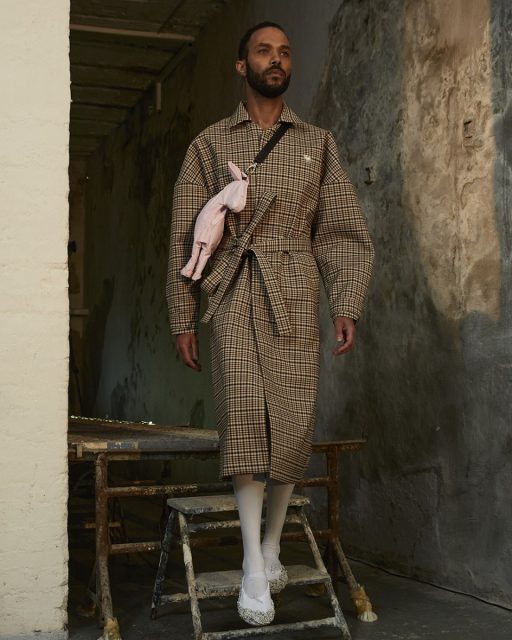 |
Special thanks to Julian Zigerli and Katja Schenker.
Runway photos by Toby.ST.
Video by Ali Zigerli.
